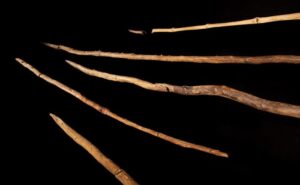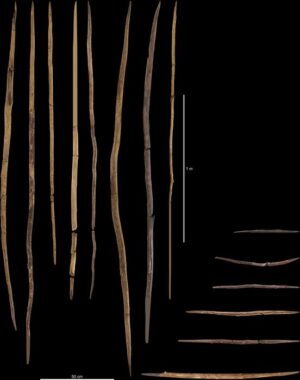
PROCEEDINGS OF THE NATIONAL ACADEMY OF SCIENCES—Researchers documented well-preserved wooden tools from a Pleistocene archaeological site in Germany. Little is known about the use of wooden tools by Paleolithic hunter-gatherers due to the poor preservation of wooden artifacts in the archaeological record. Well-preserved wooden tools have been recovered at the 300,000-year-old archaeological site of Schöningen in Germany during excavations starting in 1981. Dirk Leder and colleagues characterized an assemblage of 187 wooden artifacts identified from excavations at Schöningen 13 II-4, known as the Spear Horizon. The wooden artifacts were made from spruce (Picea sp.), larch (Larix sp.), and pine (Pinus sylvestris), primarily using splitting, scraping, and abrasion techniques. The raw materials would not have been available at the former interglacial lakeshore, where the site was located, and must have been transported at least 3–5 kilometers. Based on identification of complete and fragmented spears and throwing sticks, the authors deduced that the assemblage contained an estimated 20–25 hunting weapons. The authors also identified 35 wooden tools likely used in domestic activities, such as processing animal hides. Artifacts identified as working debris suggested that tools were repaired and recycled into new tools at the site. According to the authors, the findings expand understanding of Pleistocene woodworking techniques and provide insight into early human hunting strategies, range expansion, technical and social skills, and cognition.
______________________
What became famously known as the the ‘Schöningen spears’ were initially excavated between 1994 and 1999 from the above mentioned ‘Spear Horizon’ in the open-cast lignite mine in Schöningen, Helmstedt district, Germany. They are considered to be the oldest wood hunting weapons discovered, found in association with animal bones and other stone and bone tools. The spears provided evidence that at least this group of early human ancestors were more sophisticated both technically and socially than previously thought for Middle Pleistocene hominins.
The age of the spears were originally assessed at between 380,000 and 400,000 years old based on their stratigraphic position at the site, however, later thermoluminescence dating of heated flints in a deposit situated beneath the Spear Horizon showed the spears to be dated between 337,000 and 300,000 years old. Today, the spears are widely regarded as the oldest complete wooden weapons.
Due to the lack of evidence and data on any hominin remains at the site, scientists have not been able to determine the specific hominin, or early human, species responsible for the creation of the implements. Scholars speculate that the most likely candidates would be Homo heidelbergensis or early Neanderthals. The spears provide evidence for the use of wood in making Palaeolithic tools, and their use in hunting by Middle Pleistocene humans.
__________________________

The Schöningen excavation site. P. Pfarr NLD, CC BY-SA 4.0, Wikimedia Commons
__________________________

Schöningen spears as presented at the exhibition of the Forschungsmuseum Schöningen. Niedersächsisches Landesamt für Denkmalpflege (NLD)
__________________________

Spears and throwing sticks discovered from the Spear Horizon. Niedersächsisches Landesamt für Denkmalpflege (NLD)
__________________________

Working traces on the spear point of Spear V, including annual rings, surface facets, and a flattened knot. Niedersächsisches Landesamt für Denkmalpflege (NLD)
__________________________
Article Source: Edited from the subject PNAS news release.
*“The wooden artifacts from Schöningen’s Spear Horizon and their place in human evolution,” by Dirk Leder et al., Proceedings of the National Academy of Sciences, 1-Apr-2024. https://www.pnas.org/cgi/doi/10.1073/pnas.2320484121
___________________________
Who were the Neanderthals, really? Read the in-depth, comprehensive premium article that tells the story in the soon-to-be-released new issue of Popular Archaeology. Join today.
__________________________
Advertisement

See the incredible archaeology, architecture, and art of northern Spain. A unique tour with special expert guides and lecturers through the collaboration of Popular Archaeology Magazine and Stone & Compass Tours. Not to be missed. Read More About It: https://popular-archaeology.com/article/northern-spains-triple-a-archaeology-architecture-and-art/.
__________________________



